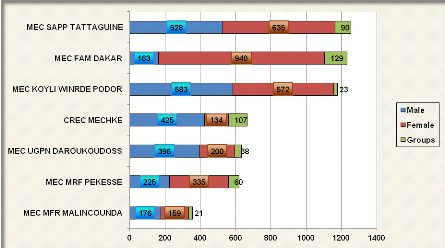4.3 Overview of FONGS FINRURAL
4.3.1 Operating areas
The FONGS FINRURAL network comprises 09 MFIs performing in 3
of the 7 agro-ecologic regions of Senegal: the «peanut basin», the
«valleys», and the «Niayes» renowned as important rural and
agricultural areas aside from the southern of the country, and constituting
about 30% of the surface of Senegal. These MFIs are the following: MEC MFR of
Malicounda, MEC SAPP of Tattaguine, MEC ARAF of Gossas, MEC MFR of
Pékésse, CREC UGPM of Méckhé, MEC UGPN of Darou
Koudoss, MEC FAM of Dakar, MEC COPED of Ross Béthio and MEC Koyli
Winrdé of Podor.
The remaining part of this paper will focus only on seven MFIs
owing to the inactivity of the MEC ARAF of Gossass and COPED of Ross
Béthio the past two years (2010 and 2011) for governance concerns.
Likewise, the data's nonentity of the two MFIs hindered their inclusion in
analyses.
All the other seven MFIs involved in the networking process
recorded diversity of experiences pertaining to their operating areas. The
average experience in the industry is about eight years, the MFI of Dakar
appearing as the eldest MFI while the MFI of Malicounda is at its early stage
of development. The experiences recorded by the MFIs (minimum of 4 years) are
important to have some insight about their performances and how they can affect
the viability of the network.
4.3.2 Membership
The figure 4 illustrates the membership situation of the MFIs as
of December 2011.
Figure 4: Membership as of
December 2011

Source: Our survey (may-august
2012)
It appears through the figure 4 that the Network affiliated
MFIs can be assorted in three wide groups while considering the accession
number: those who hold more than 1000 members (43%), those with membership
between 500 and 1000 (43%) and the small MFIs comprising less than 500 members
(14%).
The MEC SAPP of Tattaguine, the MEC FAM of Dakar and the MEC
Koyli Winrdé of Podor hold the highest membership levels (1253, 1232 and
1178 members respectively) subsequent to their seniority in the field combined
with their targeting strategies. Indeed, MEC SAPP and MEC FAM are the only
ones holding other periodic branch aside from their headquarters.
The MEC MFR of Malicounda shows up the lowest membership (326)
due likely to its youth in the industry given that it is the only one MFI with
headquarters in Malicounda. Nevertheless, the propinquity of the MEC with other
MFIs in Mbour might also induce a low membership record since the other MFIs
are developing new targeting strategies such as mobile services points.
The membership levels recorded at the MEC UGPN of
Daroukoudoss, the CREC of Méckhé and the MEC MFR of
Pékesse pinpoint their anchorage within their communities and the
willingness of their mother associations to assist them.
On the other hand, three main categories of members are
identified: Women, Men and Groups or development associations. In general, the
membership is dominated by women (representing 50% of members) followed by men
(42%) and groups (8%). This finding reasserts Armendariz (2011) who argues that
women usually constitute the main clients/members of MFIs.
Nevertheless, this trend presents specificities. For example
at Malicounda, Daroukoudoss and Meckhé, men are the most likely (with
49% and 64 % of membership respectively) albeit with tiny differences. In
contrast, MEC FAM members are more likely women (76%) because the first
women-oriented approach at the beginning.
It seems interesting to notice that overall, the membership is
growing over time. For the entire seven MFIs, the growth rate in 2010 was about
23% which is sharply higher than the average of the country (8.7%) for the same
period (MEF/DRSSFD, 2010). Nevertheless, the trend decreases in 2011 with 3% of
growth mainly owed to the decrease in membership at the MECs of Daroukoudoss
and Koyli Winrdé and at the CREC of Méckhé. Three main
reasons might explain this decrease: the competition in Mboro region (for the
MEC of Daroukoudoss), the sanitazing of the accounting of the CREC of
Méckhé, and the temporary cease of the FAIR in 2010.
| 

